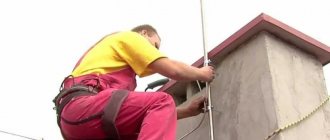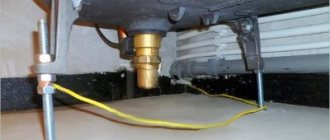Why ground a washing machine, what are the risks?
There is a stereotype in society that only old household appliances that have served for 5 years or more are dangerous. This is wrong. Machines that have recently been brought from the store and installed without following safety rules can cause electric shock.
At first, a slight tingling sensation is felt when touching the machine, and after a while (if nothing is done) a strong discharge occurs.
Electricians assure that all electrical appliances must be grounded. This applies to a greater extent to devices that are used in the bathroom due to high humidity levels. There are many outlets and appliances in this room, creating potential risks for residents.
Grounding is required for two reasons:
- If the equipment is not grounded, voltage may appear on the metal elements of the washing machine, and a person will be exposed to 110 Volts. Although small in size, this potential is enough to kill.
- Many models of washing machines that operate without grounding fail faster.
The presence of grounding guarantees safety for the user. If the insulation deteriorates and the wire in the supply circuit (inside the washing machine) breaks down, the voltage flows to the grounded circuit. As a result, a short-circuit current flows in the network and the circuit breaker at the input turns off the power.
If there is no grounding and a person comes into contact with voltage, the machine may not work. As a result, dangerous current flows through the body.
How to ground a washing machine if there is no grounding
All modern large household units require mandatory grounding. The technological process largely depends on two important factors:
- building type;
- existence of grounding in the distribution panel.
The connection operation becomes much easier if the building already has a grounding cable installed. Almost every washing machine user can easily cope with this task.
It is much more difficult to perform grounding when it is not in the panel. Working with a washing machine must be absolutely safe. After all, its operation is associated with the supply of water, which perfectly conducts current. If the machine is connected incorrectly, electric current will flow to the metal body. There is a danger of electric shock if you touch the frame.
In addition, incorrect connection often causes failure of the machine's electronic system. To replace burnt parts, you will have to pay a lot of money. Moreover, such repairs are sometimes very difficult to carry out.
In modern machines, a network stabilizer is installed to eliminate voltage drops. It is directly connected to the body of the device. If there is no ground at the power outlet, the stabilizer creates a voltage across the steel case equal to 110 volts.
Note! Typically, the washing machine is installed in the bathroom. This room always has a high percentage of humidity. Receiving a strong electric shock increases many times over.
Grounding methods
Let's highlight the main options for grounding a washing machine in a bathroom or other room.
- Connecting the housing to sewerage, water supply or batteries.
- The output of a personal socket for which the ground wire is connected from the access panel.
- Creation of a system that equalizes the potential of equipment in the apartment.
- Switching on at the RCD input.
- Making your own ground loop. The last option is suitable for cases when a person lives in a private house.
Many people make the mistake and choose the first option. Theoretically, he is working, but his own salvation may result in the following consequences:
- In the event of a breakdown on the housing and poor grounding of the elements, the potential appears on the plumbing system or battery. As a result, people (residents of other apartments) who touch the metal part at this moment may be injured.
- This method of grounding accelerates the process of metal destruction. As a result, the pipe is damaged more quickly, and the risk of flooding your neighbors and your apartment is high.
In addition, PUE and PTE prohibit this method of grounding, so it should be abandoned.
The best way is to connect a separate outlet to which a grounded wire is connected from the driveway panel. This option is suitable for cases where the house has a grounding loop (some old multi-story buildings do not have one).
The difficulty is not to confuse the working zero and the ground. If you make a mistake and connect the wire to a phase, a short-circuit current will flow in the circuit. The result is the disconnection of the power supply at the entrance (for one phase). In addition, there is a high risk of getting burned.
Another way is to connect an additional wire to a metal grounded busbar, which is grounded and runs along all floors, and then “tightly” connect the wire to the body of the washing machine.
The downside of this option is that you will have to damage the integrity of the equipment casing, and the appearance of the household appliance will deteriorate.
Solving the potential equation involves performing the following actions. The housings of metal devices in an apartment (house) are connected to each other by current-carrying elements (wires). There is a uniform distribution of potential.
If a phase hits the ground, the potential will pass along the path of minimal resistance and will not go through the human body. There is nothing complicated in implementing the scheme, so it is easy to do it yourself.
If there is no grounding in a private house or apartment and a conductor with two cores is laid, you should choose an alternative option - install an RCD or a circuit breaker at the entrance to the apartment.
Possible mistakes
There are several “handicraft” methods of grounding. They are much simpler than the “official” ones, but you shouldn’t use them. Here are the most common examples and their consequences:
- make a “zeroing”. That is, connect “ground” to “zero”. The result of this fraud is shown in the diagram below. In simple words: in the event of a break or short circuit, all appliances in the house will be supplied with 380 V instead of the standard 220 V. Naturally, the equipment will not withstand such an overload;
- connect the ground to the heating or water supply system. In this case, it will not be the washing machine that will shock, but the pipes and batteries. Moreover, they will hit not only in the swindler’s apartment, but throughout the entire house. The result will be a fine and replacement of the system, since such a connection wears out the metal very quickly (possibly leaking).
The other “old-fashioned” methods are not so popular, but just as “effective”.
Did you like the article? Tell your friends about it:
1 1
Grounding conductor color
In order to ground a washing machine without errors, it is worth knowing the requirements for the colors of grounding conductors. On sale you can find wires of various options, which are made for convenience and safety.
When arranging wiring, as a rule, the following wires are used:
- Red - phase;
- Blue - “zero”;
- Yellow-green - “earth”.
In practice, colorless or white conductors are used. In the latter case, the ground wire is located in the central part.
With this approach it is difficult to make a mistake, because when connecting you need to connect the wires taking into account the color - red to red, blue to blue. As for the yellow-green “ground” wire, it needs to be “planted” on the ground terminal.
About power wiring wires and their grounding
Any type of electrical wiring can be supplied with several circuits, each of which operates independently.
Two wires are used in the simplest implementation method. The first wire is the phase, and the second is called neutral. A third wire called “ground” is connected in the case of modern designs.
Each wire has a sheath of a certain color, if all requirements are met during the manufacture of the structure. Phase wires are indicated in red. For zero, blue is often used. Grounding wires are made in a yellow-green version, making the products easily recognizable.
Houses built a long time ago are characterized by a situation where there is no distinctive coloring. Or the wires themselves are painted in non-standard shades. Then indicator screwdrivers are used. They are also used when working with cables to check how correctly all connections are made.
Grounding the washing machine in the apartment
The method of connecting a washing machine in an apartment in a multi-storey building depends on the year the building was built. If the house was built recently and belongs to the category of new buildings, finding a grounded busbar in the panel will not be a problem.
Moreover, many houses are built taking into account each apartment, and the wires are laid with three cores.
Household appliances (washing machine, microwave oven and other equipment) have a wire with three cores, so safety is guaranteed.
If the building was erected before 1990, it is worth carefully examining the panel for the presence of a grounding busbar.
There are two ways to ground a washing machine: do the work yourself or use the services of an electrician.
When connecting independently, the algorithm of actions is as follows:
- Install two buses in the panel - neutral and grounding. Wires will be connected to them, which will go into the apartment to lighting devices and household appliances.
- Stretch a cable with three copper cores with a cross-section of 2.5 square meters from the access panel to the washing machine. mm. The wire connection is as follows. First, the blue wire (“zero”) is connected to the N scale, and then the red wire (phase) passes through the circuit breaker, RCD and is sent to the electricity meter. The “ground” (blue-yellow conductor) must be connected to the ground bus. It is prohibited to combine grounding and working zero.
Next, all that remains is to install the outlet and connect it. This requires a socket, an indicator screwdriver, pliers, a cable with three cores, a knife and a socket with a grounding terminal. If the considered set of works seems complicated, you should entrust the work to a master.
READ MORE: How to install an outlet in the bathroom.
What can be done to prevent the machine from electrocuting?
As you already understand, diff protection only turns off the voltage during leaks; the cause of this leak is not eliminated. Therefore, you can take all possible measures to prevent the causes.
1.
Install current leakage protection, RCD or differential circuit breaker. This does not guarantee the absence of electric shocks, but it can protect against serious consequences.
2.
Disconnect the middle terminal of the input capacitors from the chassis if possible. Since the case is not grounded, capacitors are essentially useless and even harmful.
3.
Dry the insides of the machine with a hairdryer, if possible, check the integrity of the corrugated pipes - perhaps they cause excessive moisture.
4.
Unplug appliances between washes. Yes, it’s inconvenient, but there’s no other way.
Actually, that's all that can be advised. As you can see, there are no super ways, but such is life... with old wiring and lack of proper grounding.
In a private house
Connecting the grounding of a washing machine in a private house differs little from the algorithm discussed above. The ground wire is also led from the main panel.
The difference is that there is no grounding at the entrance, and you will have to do it yourself. Previously, the installation process was briefly discussed, but here are detailed instructions:
- Find three metal pipes ranging from one and a half to three meters in length. When choosing the length, keep in mind that it should not be less than the depth to which the ground freezes in winter.
- Use a sledgehammer to make a point at the bottom of the pipe and drill 0.5-1 cm holes here.
- Dig a hole to a depth of 50-60 cm, then drive the pipes into the ground at a distance of one to one and a half meters. 100-150 mm of pipe should remain above the surface.
- Find three metal plates (you can use reinforcement) 100-150 cm long, then weld them to the edges of the pipes located above the surface.
- Weld a ground wire to the fittings, which will go to the meter installation site. The installation method is selected taking into account local conditions.
- Connect the grounding wire to the PE bus, and then branch the grounding wires to lighting and sockets.
For reliability, the grounding wire is attached with a bolt to the back of the machine (such a bolt is already provided by the manufacturer).
What mistakes are made when doing work?
The main thing is to correctly understand which route the current moves, starting from the transformer substation and ending with the consumer.
You should also remember how the path works in the opposite direction. It is necessary to take into account important nuances such as the ways in which protective PE zeros and working N zeros are formed.
Separation of PEN conductors
The principle of creating protective as well as working conductors can be performed using different methods:
- On low-voltage equipment. A 0.4 kW supply substation is used, as well as a TN-S system.
- On the ground loop of a multi-story building. It is assumed that it will be converted using the TN-C-S scheme.
The first method assumes that there are five cores in the cable coming from the TP. These are two conductors, grounding and neutral, as well as three phases. In the second case, there are as many as four conductors, since the PEN system comes in unsplit form.
Zeroing of household appliances and existing dangers
If the scheme given above is used, the working and protective conductors are combined on the main shield. This is the designation of the main bus when grounded. Given such a scheme, users often make mistakes when connecting household appliances.
The opportunity to save on laying one core appears if the following conditions are met:
- The owner of a house or apartment does not pull a PE conductor from the input cord.
- The protective contact of the socket is combined with the working zero.
This method is called zeroing. It is used in a two-wire system so that workers receive additional protection from breakdown of the insulation layer on the housing.
Zero potential is initially present in the system. Therefore, a short circuit immediately appears, which is turned off thanks to an automatic device. This principle was used when craftsmen had only old instruments at their disposal, the body of which lacked insulation.
Now the zeroing method is considered erroneous, and there are reasons for this:
- Wires and cables are disconnected when the apartment is being renovated or electrical circuits are being checked. In practice, the ends of phase and zero are quite often confused with each other. After this, the devices retain almost the same functionality, but the phase potential appears on the body, and not zero.
- It is easy to confuse the order between zero and phase if the plug is removed from the socket and then reinserted after some time.
In both cases listed above, current will flow through the human body. This happens whenever users simultaneously touch the washing machine and the faucet, batteries, or other similar structures.
Random grounding electrodes and their connection: difficulties
An additional connection to the ground circuit can be waived if the buyer is the owner of apartments with a three-wire system. But those who only have access to a two-wire option should seriously think about this issue.
What could be dangerous in this case?
- There is no guarantee that normal contact with ground is ensured and that it is permanent.
- Dangerous potential arises during accidents on communication networks.
- The grounding system of a multi-story building can be disrupted when using homemade circuits. After all, electricity supply chains appear that were not initially provided for. Therefore, careful recalculation is required.
Ground wires: laying rules
Even if the electrical circuits of washing machines are well insulated, the presence of a grounding wire is a mandatory requirement. After all, modern devices have special capacitor-type network filters built into the housing.
Circuit solutions are used that lead to a discharge to a person with an initial power of up to 110 Volts. This occurs if the user touches an ungrounded chassis.
The absence of a grounding wire means that the owner of a house or apartment can do the work on his own without involving specialists. Then the process of connecting equipment to the appropriate circuits at the electrical panel will be simplified.
The neutral and grounding bus make up the electrical panel, from which the resource is supplied to specific consumers. These components are easy to identify visually if no manufacturing requirements are violated.
European-style sockets in French or German style become connection elements. They will be a kind of separate grounding contacts. The main thing is that it is easy to connect to both types of outlets.











